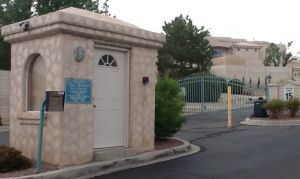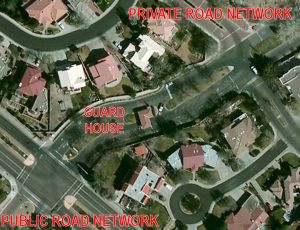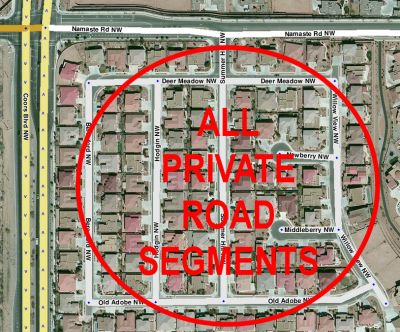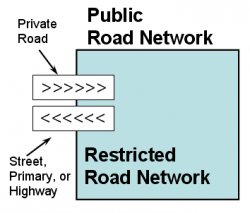Introduction
Definition



A Private Installation or Community is a small to large restricted-access set of regularly navigable roads connected at one or more points to a public road network. The smallest example may be a single private community street protected by a gate. The largest USA installation is White Sands Missile Range at 3,200 square miles, larger than the USA’s smallest state, which includes dirt roads, primary streets and highways. We wish to address such locations because many people work and live within private installations and Waze should be capable of serving their needs as well as preventing erroneous routes through private installations for those who do not have access.
Actual access restriction in these installations or communities is usually implemented by gates or guards that only allow entry by authorized individuals or vehicles. An unmanned means of preventing one-way access could be tire puncture strip that would deflate tires of vehicles going in one direction. In some cases access may be unrestricted by physical means, but may be implemented through patrols, cameras, or other means that would lead to a response to apprehend an unauthorized visitor.
A private installation, particularly larger government facilities, may have nested levels of access control. A particular region of the installation may be excluded to those who have general access to the larger installation. Larger examples may have all types of roads such as primary streets and highways. Smaller examples would only have roads and dirt roads.
Purpose

Waze should not automatically route onto or through a private installation unless the source or destination point is within the installation. Figure 1 shows the general concept of a private installation which is embedded in a public road network. In this case there are two access points. Waze should route around the private installation from A to B even though a shorter or faster route might exists through the installation. Waze should also be able to route from A to C or C to A, where C is located within the private installation.

Figure 2 shows that some, usually larger, private installations may have nested levels of access. Waze should be able to route on or off of a private installation at any level of nested access without entering a separate access area of a deeper level. Route A to B illustrates this concept. Additionally, Waze should be able to navigate from a deeper level of nested access to any other point including off the private installation. Routes between points C and D illustrates routing onto or off of the private installation. Routes between points E to F shows navigation between nested levels. Waze should also be able to navigate well within a larger installation that has multiple road types.
Approach
We suggest two separate approaches for treatment of these installations or communities, one for smaller installations and one for larger installations. Due to the large variability in these installations or communities, the editor may have to adjust or combine approaches based upon the details of the particular installation or community. Therefore benefits and detriments of listed approaches are provided as guidance.
Landmarks / City Names for Private Installations
Certain private installations might be identified by either landmarks for smaller and private installations or the city name field of streets for larger, usually government, installations like military bases. Specific guidance is given on the following pages:
In general here is specific guidance about Private Installations use of Landmarks or City Names:
- Does the state DOT consider it a city? If so, then use City Names.
- Does the US Post Office consider it a city with it's own zip code? If so, then use City Names.
- Does the local community consider it a city like entity? Then maybe it should have a City Name if it is large, or a Landmark if it is small.
- Is it large enough that an overall landmark on the Private Installation would obscure finer detail landmarks below? If so, use City Names. If not, use a Landmark to denote the Private Installation.
Background Testing
Significant testing of these suggestions have been tested on actual private installations of various types and discussed in the Waze Forum. You may wish to test your edits. Here are some suggestions of how you may accomplish this after you make edits.
- Monitor that area for User Reports.
- Test drive.
- Navigate between two distant points outside the private installation to ensure no through-routing.
- Navigate from outside to inside the private installation, drive around the outside of the private installation and ensure rerouting occurs to the logical nearest gate.
- If you have access to the private installation, repeat the above, by by driving around inside the installation.
- Test routes in Live Map to ensure no through-routing and good on/off installation routing.
- Test routes in client by setting various "from" and "to" destinations without having to drive.
Smaller Installations
Definition - Smaller Installations
Smaller installations are those private installations or communities with few roads that can be easily represented by only normal street types and that have a single level of access control. Specifying exact size is not effective because of significant variation in these installations. Typically these attributes might indicate an installation is small: (a) less than 20-30 roads, (b) no secondary or highway streets needed.
Moderate sized installations between "smaller" and "larger" will exist and discretion of the local editor should be considered.
Examples
- Small gated/private community
- Gated country club with smaller area
- Private school
- Small closed commercial campus
- Very Small Military sites (e.g., National Guard armories)
- Smaller Government sites
This does not include paid parking lots and other parking facilities. These are to be mapped with parking lot roads. See the Special Rules section below.
Preferred Approach: Smaller Installations

Mark all roads internal to these areas as private roads.
Benefits of this approach are simplicity and a more robust solution to naïve editor error. If a new connection is made to this private road network from the public road network, no additional traffic will accidentally route through the region. In addition, manual locks are not usually required which allows other editors to more easily make changes.
Detriments of this approach are that no dirt roads, primary streets, or highways may be identified and multiple levels of access control are difficult or impossible.
Smaller Installation: Other Notes / Details
A. Mixing road types in a smaller installation
Because smaller installations are often most easily handled with all private road segments, we presented just one approach. Editors may see need for mixing other road types such as street, dirt, and parking lot within a smaller installation. Note that a single rogue normal street segment or clusters of street segments within an area set to all private roads will be avoided similarly to a private road or cluster of private roads within an area of street segments.
Larger Installations
Definition: Larger Installations
Larger installations are those private installations or communities that are large enough such that there is some reason to have primary streets or highways or because that installation requires multiple levels of access control (installations within installations). Specifying exact size is not effective because of significant variation in these installations. Typically these attributes might indicate an installation is large: (a) more than 20-30 roads, (b) secondary or highway streets needed.
Moderate sized installations between "smaller" and "larger" will exist and discretion of the local editor should be considered.
Examples:
- Larger Military base
- Larger Government sites
- Huge hunting lodge and hunting grounds, ranches, etc.
- Large closed commercial campus
- Large country club or private communities with multiple entrances
Private installations covered by this article do not include airports or theme parks. See the bottom of this article for special rules concerning roads in airports and theme parks.
Larger Installation Treatment common attributes:
The general approach is to isolate the entire installation from the public road network with private roads or one-way exit roads. This will prevent Waze from routing through a private installation unless the route begins or ends on the installation. All roads within an installation will be of type appropriate for that road (dirt road, street, primary street, minor highway, major highway, freeway). In order to prevent novice editors from changing these access controls, the private and one-way roads, and any necessary connecting roads should be locked at a level as high as appropriate or possible.
Benefits of the two following treatments are allowing full use of road types within the installation resulting in better routing and a simple logical notion that the private segments (or one-way segments) represent the gates or guards on a road protecting entrance into an installation. It also allows nested levels of access control. The approach for smaller installations does not allow this to occur.
Detriments of the two following treatments are that the private road segments isolating the installation from the public road network and internal nested installations should be locked to prevent change by novice editors. In addition, a novice user could connect one or more new roads between the installation and the public road network that would potentially begin to have Waze route through installation roads that are not accessible; however, this would require two such errors by the novice and should result in URs and those areas could be repaired and locked in the future.
Warning: Do not mix the two treatments (preferred & alternate) shown below on the same nested level of a private installation. If you do, exit routing from an installation would favor the one-way regular exit roads and avoid the two-way entrance/exits. This would create incorrect exit routing. You may mix the preferred/alternate treatments at different nested levels. For instance you may use the preferred treatment at the first level of an installation and then use the alternate treatment for a second internal nested level.
Preferred Treatment: Larger Installations

Each entrance to the installation should be connected by a one-way split road entering and exiting the installation. The entering one-way road will include one private road segment. The exiting one-way road will be of one segment using the appropriate type of that road (usually street, primary street, or minor highway). This structure often mimics the actual lanes for such installations. The private road segments, one way exiting segments, and surrounding roads should be locked with a high enough level lock to prevent novice editors from deleting or changing this control.


Nested private installations (wholly within another private installation) will likewise be isolated in the same manner or Alternate Treatment from the larger installation.
Benefits of this preferred treatment is that it allows the exiting road to be of any type and of no penalty to routing out of the installation.
A detriment of this treatment is a more complex structure than the alternate treatment for larger installations.
Warning: See warning above in the "Common Attributes" section about mixing the preferred and alternate treatments within the same nested level of a private installation.
Alternate Treatment: Larger Installations

An alternate approach for these installations is to connect to public road networks through one short private two-way road segment at each entrance or exit to the installation. This effectively isolates the entire installation from the public road network unless a route begins or ends within the installation. All roads within an installation will be of type appropriate for that road (dirt road, street, primary street, minor highway, major highway, freeway). The private road segments and surrounding roads should be locked with a high enough level lock to prevent novice editors from deleting or changing this control.

Nested private installations (wholly within another private installation) will likewise be isolated in the same manner or Preferred Treatment from the larger installation.
Benefit of this alternate treatment is that it is structurally simpler than the preferred treatment.
Detriment of this treatment is that it does not allow any road type to be used for the exiting protective one-way segments in the preferred treatment.
Warning: See warning above in the "Common Attributes" section about mixing the preferred and alternate treatments within the same nested level of a private installation.
Larger Installation: Other Notes / Details
A. Public Roads Across Private Installations
Many larger military bases and perhaps other private installations sometimes have long right-of-way permissions for a publicly accessible road, often times this is a highway or primary street. (e.g., US-70 through White Sands Missile Range.) These highways run across the private installation with no restriction to traffic but provide no access to the installation itself. Editors should not create any access restrictions in these regions. Because these roads are often times fenced off on both sides from the private installation, editors should be on the look out for private installation roads inappropriately connected to the public road. These are usually locked off by gates most of the time, in which case the road can be disconnected or have a gap. Some of these are entry/exit gates with treatments noted above.
B. Preventing Other Editors from Making Mistakes
One method of preventing mistakes from novice editors has already been discussed, locking of the private road segments and surrounding segments. There is another approach that may be valuable.
Larger private installations, such as a military base, that are embedded in a city often have legacy roads that used to connect to the public road network. From the Waze Editor aerial images, it can look like these roads actually connect to the private installation, when upon closer inspection (if possible) there is really a fence that permanently blocks the road. There may also be a fence gate that is closed most of the time, only opened when guards are present. In both these situations, there should be no road connection, or a gap in the road network within the Waze Editor.
Novice editors or experienced editors that are not paying attention, may accidentally connect these roads when they should not be connected. One could lock these segments. One may also put a signpost only available to editors noting this issue. Until Waze implements signposts for editors, a small strip of a two-way Railroad can be placed across the gap in the road network with the word "FENCE" as the name of that Railroad segment. This should alert and remind editors that the roads should not be connected. These short Railroad segments are not visible in the client.
C. Gate Closures and Restrictions
Many larger installations will have access/entry points or gates that have limited hours or that are closed on certain holidays. Utilize Scheduled_Restrictions in the editor to allow Waze to know when to route through a particular gate. These are typically not turn restrictions, but restrictions on traversing a segment. Some gates can be very isolated on larger installations so routing may navigate someone 10 to 30 minutes to a closed gate.
When doing this, enable Scheduled_Restrictions for only one segment in each direction to reduce editing errors and maintenance. This segment should be the private road segment on the inbound direction (or the single two-way private segment). For entry points with a one-way outbound regular road type, it should be the segment adjacent to the private inbound segment. Scheduled restrictions would usually be the same on these two segments unless the private installation has differing entry and exit policy.
You can find the hours of gates or entry points through the private installation website or by calling the appropriate private installation authority.
D. Landmarks for Access/Entry Points
Entry points for larger Private Installations are typically named such as "North Gate" or "Maxwell Gate." These are landmark areas that are useful for those using Waze to understand their location relative to the Access Point. It is suggested a landmark of type "Other" be generated over the larger region of the Access Point and named with the short name of that Access Point. Do not make the landmark just the size of the guard houses or other features. Make it large enough to encompass the area so that it is easily seen on the Waze client.
If you do not know the name of the Access Point, do not create a landmark. Names of Access Points may be known locally or found on on a website about the private installation.
Installations with Special Rules
Airports
Do not map the private, restricted-access roads on airport grounds at all. Map airport roads which are accessible to the public (terminal pick-up/drop-off roads, parking lot access roads, etc.) as public roads, not as private installations.
Airports have "air-side" restricted road networks that allow traffic for baggage carts, service vehicles, airplane fuel tankers, etc. While it may be tempting to map this road network either as an isolated set of roads or with provisions cited elsewhere in this document for Private Installations, this should not be done. Here's why:
- A large number of people use Waze to navigate to airports. The particular search service or function that returns a GPS coordinate to Waze may be in error, placing the destination marker nearer to the air-side private road network of the airport than to the public airport roads. This could lead to an incorrect route or even an impossible-to-reach destination, which would frustrate the traveler.
- The private air-side road network of an airport tends to be both close to and accessible from the public road networks around the airport and therefore is more prone to this navigation error.
- Very few people use the private road network of an airport, relative to the great number that use an airport's public access roads. To those that have requested this function, we apologize. The benefit of doing this for few would likely inconvenience many. We suggest routing to the nearest spot to your destination (i.e., the gate) on the public road network.
In some cases, military bases hold public airports. In such situations, some discretion and creativity may be needed to decide which roads on the airport should not be mapped and which on the military base should be mapped. Usually there is a second perimeter around the airport separating it from the base.
Theme Parks
Publicly accessible roads in a theme park even after a pay-station/gate. (Generally do not include these roads unless Waze would normally route through them inappropriately. If Waze does route through a theme park as a short cut, then mark these areas with one of the treatments below.)